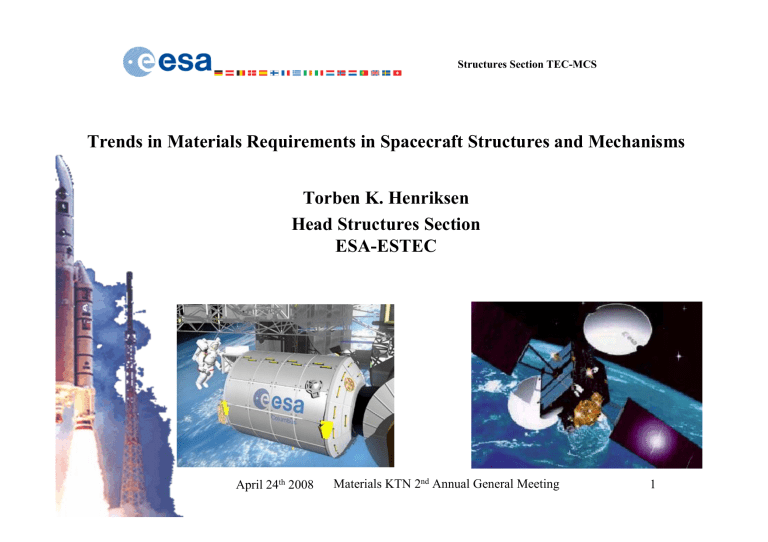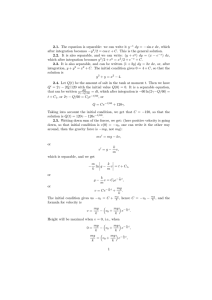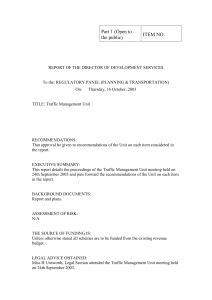
Structures Section TEC-MCS Trends in Materials Requirements in Spacecraft Structures and Mechanisms Torben K. Henriksen Head Structures Section ESA-ESTEC April 24th 2008 Materials KTN 2nd Annual General Meeting 1 Structures Section TEC-MCS Presentation content • Where do we need materials developments near term for our structures and mechanisms? • What are we currently doing about it? => My main objective: - Stimulate possible cooperation with you! - Your research currently ongoing; Related research you have foreseen; Research you might perform in the future; April 24th 2008 Materials KTN 2nd Annual General Meeting 2 Structures Section TEC-MCS Spacecraft: Material improvements needed everywhere! Solar array substrate & equipment panels: stiffness, conductivity, in-orbit curing, damping Envisat Antenna reflectors: stability, stiffness, conductivity, in-orbit curing Fasteners & inserts mass, strength, conductivity icotec ag, Switzerland Equipment: Conductivity, stability CASA Spain Primary / secondary structures: strength, stiffness, conductivity! ESA/ESTEC The Netherlands April 24th 2008 Materials KTN 2nd Annual General Meeting 3 Structures Section TEC-MCS Spacecraft: Material improvement needs: Launcher structures Composite structures strength, manufacturing processes, damping; Elevated temperature bonding technologies (300-400 C) Materials and coatings for high temperature applications: metallic and ceramics. Propulsion subsystems. transverse stress σ2 [N/mm2] Improved analytical/numerical design verification methods: Damage tolerance methodologies for highly loaded welded metallic structures, composites, ceramics; Puck Puck Tsai -Wu Criterion Test Results IKV TS1 O. Fischer Swanson et al. Welsh & Adams TS2 TS3 TS4 April 24th 2008 2 fibre parallelσ1stress [N/mm [N/mm ] Materials KTN 2nd Annual General Meeting 4 Structures Section TEC-MCS Summary of Near Term structural material development requirements: • • • • • • Increased stiffness to mass ratio; Better Conductivity: electrical and thermal; Thermo-elastically stable – (zero CTE materials please!) Ability for in-orbit curing; Simplified manufacturing processes; Better understanding of material behaviour (failure predictions, stability ..) April 24th 2008 Materials KTN 2nd Annual General Meeting 5 Structures Section TEC-MCS Structural Materials as we know them today! • Mass is a driving requirement => light, stiff and strong materials are required. – Composites, based on long carbon, Aramid or glass fibers, with an epoxy or cyanate ester resin. Often the interface parts (brackets, rings etc) are made from aluminium or titanium alloys (the latter is preferred!!). – Often a sandwich structure is used, with an Aluminium honeycomb core and a CFRP faceskin. For cases where mass is less critical, or due to thermal reasons Aluminium faceskin is used. April 24th 2008 Spacebus central tube development, Astrium CASA Carbon fiber tube insert (DLR) Materials KTN 2nd Annual General Meeting Qual model of the Spacebus central tube and central tube during demoulding (courtesy Saab Ericsson Space) 6 Structures Section TEC-MCS Structural Materials Cont – Joints: bonded joints, rivets and high strength fasteners. – For thermally stable benches / platforms as well as for hot structures ceramic structures are applied (e.g. C-SiC Carbon Silicon Carbide, SIC, Ce-SIC) Payload adapter, Astrium/CASA – All materials used are qualified wrt stress corrosion, offgassing (toxicity, flameability for manned missions) April 24th 2008 Materials KTN 2nd Annual General Meeting Aladin, (Astrium) 7 Structures Section TEC-MCS Composite materials for antenna structures: • • • UHM Carbon fibres in Cyanate Ester resin systems to-days baseline: => constitutes the basic building block for the state-of-the-art antenna reflector technologies. New generation cyanate ester resin systems show superior performances in terms of microcracking, moisture absorption and thermal and thermo-elastic behaviour. HSASS (HPS) antenna reflector in FH Munich Compact test range Pitch Carbon fibres provide an improved thermal and electrical conductivity, as well as elastic modulus. An example of pitch Carbon fibres with cyanate ester resin implementation is the Highly Stable Antenna Surfaces developed under ESA contract (HPS and Invent GmbH Germany). => Still rely on many materials from outside Europe. HSASS (HPS) antenna reflector in DLR TV chamber for distortion measurement with Laser Speckle interferometer. April 24th 2008 Materials KTN 2nd Annual General Meeting 8 Structures Section TEC-MCS What are we doing about it today: • A snapshot! A number of development activities are – or are foreseen to be- supported by ESA. 1. Inflatable structures: Materials for rigidization (curing) in –orbit; 2. Stable structures: Methodologies for application of ceramics in structural applications; 3. Antenna structures materials developments 4. Composite Structures: Carbon NanoTubes (CNT) doping of CFRP; 5. Electro-Active Polymer Actuators for structural applications! April 24th 2008 Materials KTN 2nd Annual General Meeting 9 Structures Section TEC-MCS 1.0 Inflatable Structures • • ESA has initiated the development of technologies for large inflatable structures. Technology Goals: – Development of inflatable spacecraft structures: • booms and toroidal structures elements as building blocks • lower mass compared to classical mechanical structures • small stowed volume • lower production cost • reliable deployment => Flight demonstration mission next step! – Potential applications of the inflatable technology: • • • • • solar arrays sunshields antennas solar sails booms April 24th 2008 Materials KTN 2nd Annual General Meeting 10 Structures Section TEC-MCS 1.0 Inflatable Structures: Driving requirements • Driving requirements for the composite materials: – – – – – foldable materials; long-term storage in uncured state; low outgassing; rigidisable (curing) in space. Preferably reversible rigidisation. Testability, flight hardware verification. – low energy curing; (light,UV,thermal) – high performance fabrics • epoxy resin glass fibers UV curing (Astrium-SAS France) Problems areas encountered: – outgassing; – rigidisation in space environment; – mechanical properties after curing not as needed. epoxy resin carbon fibers +45/0/-45 thermal curing (ThalesAleniaSpace France) April 24th 2008 epoxy resin glass fibers 0/90 visible light curing (Astrium-ST France) Materials KTN 2nd Annual General Meeting 11 Structures Section TEC-MCS 1.0 Inflatable Structures: Rigidisation / Curing needs. Why rigidisation? z Inflated structure (e.g. reflector, boom) deployed in orbit by pressurisation → gas loss overtime! z Requires rigidisation that permanently ‘freezes‘ the shape → permanent rigid in space. How? before and after thermal Mechanical rigidisation (Kapton/aluminium laminates) Physical rigidisation (e.g. shape memory, solvent evaporation → outgassing) Chemical rigidisation (e.g. thermal/UV curing, gas catalysed polymerisation) Carbon braid impregnated in thermoplastic polymer matrix INASMET Spain => Have not been as successful as expected. Developments still running with Astrium, based on visible light curing. Additional new R&D program to start 2008: April 24th 2008 Materials KTN 2nd Annual General Meeting 12 Structures Section TEC-MCS 1.0 Inflatable Structures: Polymerisation in Free Space Thin-film solar-array Astrium-ST Ground testing of flight demonstrator; Artificial light sources inside of boom Degree of curing achieved not yet adequate; Combination with thermal curing being studied; Additional Challenges: -Reduction of low molecular weight species to reduce outgassing (very critical for uncured resin, less critical for cured samples); -Influence of space environment (particle, electromagnetic); -Resin storage (long term storage on ground required); => Master the material curing process and you will master inflatable structures for space applications! April 24th 2008 Materials KTN 2nd Annual General Meeting 13 Structures Section TEC-MCS 2.0 Stable Structures: Application of Glass and Ceramics; Ceramics and glass materials used for mirrors, optical benches and payload module structures where high thermo-elastic stability is required; -SIC: sintered high purity silicon carbide; Manufactured by Boostec, France, CTE matched to Invar High specific stiffness High thermal conductivity Large structures can be fabricated from smaller segments Expensive to produce -CeSIC: reaction formed silicon carbide; Manufactured by ECM, Germany CTE matched to Invar Good mechanical properties High thermal conductivity Can be machined by EDM Optical bench ECM Large structures can be formed by assembling carbon green bodies - CFRP Carbon fiber materials with exopy or cyanate ester resins. GAIA optical bench made from SIC (Astrium) app 3.8m diameter -Zerodur: glass; Manufactured by Schott,Germany, Ultra low CTE Better than 0±0.1ppm/K, 0±0.05ppm/K or 0±0.02ppm/K, Low strength <10MPa Materials KTN 2nd Annual General Meeting April 24th 2008 14 Structures Section TEC-MCS 2.0 Stable Structures: SiC based Ceramic materials – SiC 100 from Boostec (France), stable isotropic – CeSiC from ECM (Germany), CTE =0 at low temperature. Mirror 0.95m CeSiC April 24th 2008 Petals of Herschel telescope SiC 100 Materials KTN 2nd Annual General Meeting 15 Structures Section TEC-MCS 2.0 Stable Structures: Complete optical instrument: NIRSpec • • • April 24th 2008 Near Infra-Red Spectrometer for JWST SiC100 optical bench and some optics Operates at 30K Materials KTN 2nd Annual General Meeting 16 Structures Section TEC-MCS 2.0 Stable Structures: Problems and Related developments Structural integrity verification approaches; - numerical modelling; - testing methodologies; Due to the absence of ductility, the strength of glass and ceramics unlike metallic materials depends on many factors as : • • • • • microstructure of the material ; size of the grains ; defects, porosity; manufacturing methods including special contribution of surface finish/residual stresses; load application with a specificity since the compressive strength is much higher than the tensile strength; Volume of the material submitted to stresses; Test conditions as loading rate, and duration ; temperature environment… ⇒ How do we derive design allowables? ⇒ What are the failure modes and how can we model this in the design phase? ⇒ How do we determine the material properties e.g. low temperature CTE? Related R&D program to be initiated by ESA in 2008 April 24th 2008 Materials KTN 2nd Annual General Meeting 17 Structures Section TEC-MCS 2.0 Stable Structures: “Accurate Thermo-elastic numerical analysis of materials for spacecraft applications” Sponsoring a Ph.D. programme with Manchester University (Mr S. Vendel, Dr Lee Margetts) • • • • Characterisation of the microstructure of foam materials, employing image acquisition and scanning techniques. Conversion of the microstructure of the material into detailed FE models. Generation of the macro-scale models taking into account the microstructure of the materials. Correlation with samples and analysis of benchmark cases. X-Ray microtomography April 24th 2008 Smooth Finite Element Mesh 3D Stress Visualisation Finite Element Mesh Materials KTN 2nd Annual General Meeting 18 Structures Section TEC-MCS 3.0 Antenna materials developments • Ultrastable Carbon honeycombs for antennas: – New developments have been started in Europe in order to provide an alternative to the ITAR restricted available products. (e.g. with INVENT/HPS Germany, Eurocomposites Luxembourg) • Process automation for antennas: Carbon honeycomb core in full CFRP sandwich (HPS&Invent). – Layup mostly made by hand today! However Fibre Placement machines provides repetitive and controlled lay-up with improved stability performances. Antenna reflector manufacturing by Fiber Placement currently being studied under ESA contract. April 24th 2008 Materials KTN 2nd Annual General Meeting 19 Structures Section TEC-MCS 3.0 Antenna materials developments: Multi-Scale Modeling of Advanced 3D Composite Materials for Ultra-Light Antenna Application. ESA funded R&D program with e-XStream (Lux). Micromechanical and RVE (representative volume element) modelling employing DIGIMAT April 24th 2008 Materials KTN 2nd Annual General Meeting 20 Structures Section TEC-MCS 4.0 Carbon Nanotubes (CNT), nanofiber based structural materials CNT diameter as small as 1 nm, Length up to centimeters. Young’s modulus > 1 Tera Pascal; Thermal conductivity 3000 W/mK; Excellent electrical conductivity; Various studies have demonstrated the potential benefit of doping CFRP with CNT or nanofibers: (e.g. Epoxy or Cyanate-ester resins) • Strength & stiffness; • Conductivity, electrical and thermal; • Damage tolerance, toughness; (doping to a few wt % in the resin) Ceramic based materials: Located at grain boundary increase in fracture toughness April 24th 2008 Materials KTN 2nd Annual General Meeting 21 Structures Section TEC-MCS 4.0 Carbon Nanotubes (CNT) and nanofiber based materials • Application in spacecraft structures and subsystems to be studied in more detail (antenna, radiators, instrument panels etc) – Antenna structures (electrical conductivity – Radiators (thermal conductivity) – Spacecraft panels (thermal conductivity, stiffness, strength) • Consider CNT as well as nanofibers, possibly in combination with pitch carbon fibers; => Properties revolution not expected, enhanced / enabling improvements seems realistic; • • Main problem: Consolidation of material processes: - pre-treatment of CNT for removal of impurities; - good dispersion in the resin; - alignment for high volume fraction CNT based materials; Two new R&D projects to be initiated by ESA in 2008: – Application in telecom spacecraft; – Near Term application in spacecraft and launchers; (conductivity, damping, damage tolerance) April 24th 2008 Materials KTN 2nd Annual General Meeting 22 Structures Section TEC-MCS 5.0 Electro-Active Actuators for structural applications! Dielectric Elastomer Actuators (EAPs) under development for applications like: -Damping of flexible structures: -Shape control of reflectors: -Multi-layer technology, 1.5kv-3kV actuation, -Environmental tests completed successfully; (thermal, vacuum, radiation) Planar sensors developed by Risø (DK) Buckling actuators developed by Centro Piaggio, Univ Pisa (I) Antenna shape control / reconfigurable antenna. Prototype actuator of the C/II type. Breadboard boom 4 layers. Polyester textile is used segment with actuator as mechanical connectors. inserted. Graphite filled silicone connects the individual layers, Cu-wires, and the textile to the actuator sheets. April 24th 2008 Materials KTN 2nd Annual General Meeting 23 Structures Section TEC-MCS 5.0 Electro-Active Actuators for structural applications! Poly(dimethylsiloxane) – PDMS Silicone (Wacker Elastosil™ RT 625) EAP actuator inside CFRP boom Cycle testing of EAP sensor/actuator April 24th 2008 Materials KTN 2nd Annual General Meeting 24 Structures Section TEC-MCS Analysis of Composite Structures - ESAComp • • ESAComp is a state of the art software tool for analysis and design of structures made of composite materials; Capabilities: – – – – – – – • • • Solid and sandwich composite structures Materials Database Micromechanics Laminate analysis and design Beams, plates, stiffened plates Bonded and mechanical joints Import from and export to many commercial finite element programs The tool is widely used in the European space industry. Industrial Partners: Helsinki University and later Componeering (Finland), ESA contract; http://www.componeering.com/esacomp/ April 24th 2008 Materials KTN 2nd Annual General Meeting 25 Structures Section TEC-MCS Conclusions -Some of the most pressing material development requirements for spacecraft structures highlighted. -several other areas have not been discussed today but are also of interest- e.g. gridstructures, draping of prepregs, RTM and related injection processes, braided and stitched composite materials, oxidation coatings for ceramics etc. etc. It is clear that: - Structural material developments are essential to enable future space missions! - A joint effort by Agencies, academia and the space industry is needed. -Increased cooperation with academia (R&D programmes, PhD programmes….) is needed. Are you performing – or interested in performing material developments in the areas mentioned, we would like to hear more about it. April 24th 2008 Materials KTN 2nd Annual General Meeting 26


